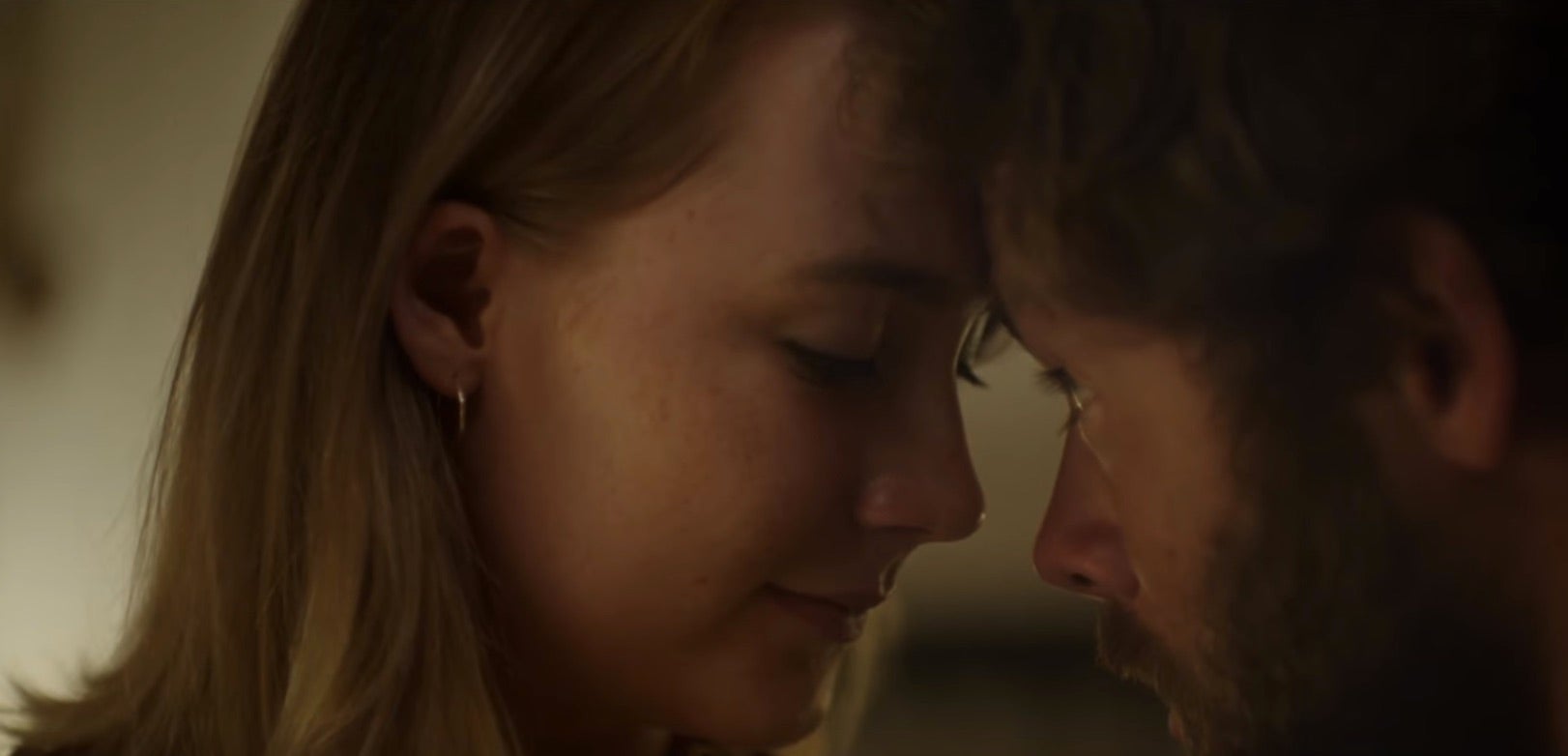To call awareness, the music video reveals the dynamics of an abusive relationship. As Hozier notes in reference to his song, “I tried to get across the difficulty of coming to terms with and facing up to domestic violence…” Specifically, the video highlights how domestic violence can be obscure within a relationship when disguised by love, therefore making it difficult for the victim and for others to identify abuse.
Throughout the video, the scene switches back and forth between a woman at her vanity removing her makeup, and a flashback scene to her and her partner returning home from what appears to be a date.
The introduction shot opens up to an image of a heart mantle made of twinkling lights and branches. This ornament looms above the female protagonist who is staring into her wide vanity, as she gets ready for what seems to be a date. Adorned around her neck is a delicate heart pendant.
There is a reoccurring use of hearts, first from the décor above her vanity, and then from the necklace she is wearing. As discussed by Danesi in Messages, Signs, and Meanings, the signification of the signifier can be conveyed using the connotation applied to hearts, which are feelings of love and romance. In our culture, the heart-shape is a concept of the abstract referents, intimacy and adoration. An example of this would be the hearts signs constantly used throughout Valentine’s day, ideally the most romantic day of the year.
Yet as the story line moves forward, we see the woman progressively removing her makeup, to reveal a disturbing purple bruise encircling her eye. She does this all the while staring intensely at her own reflection in the vanity mirror. This cleaning process represents this woman seeing the hidden truths of her relationship, as she wipes away the deceptive makeup to uncover the actual horrors.
The mirror and removal of makeup are both strong symbols of exposing ones true self. When a women removes her makeup—a tool for covering up imperfection, she is effectively exposing her “raw” self. The mirror acts to reflect this image back to her, forcing her to be the one to confront her own reality. The bruise and red-streaked crying eyes against her previous made-up face are contrasts between the ugly truth, and the pretty fantasy of the relationship.
In contrast, the other recurrent scene shows the couple’s relationship dynamic as they arrive home from their date. This scene evokes a synesthetic experience of distortion and drunkenness. The shots appear to be slower in motion, exaggerating their movements and expressions.
This is paired under the assumption that they have been drinking as they both seem giddy, joking around and passionately kissing around the room. As mentioned by Beasley and Danesi in Persuasive Signs, this experience allows the viewer to experience aesthesia, an affective response to these techniques.
Within this scene, there is a symbolic moment where the partner offers the woman wine, which she accepts. Wine, is often a signifier of romance and lust, yet within the larger context we extract a new meaning. As discussed by Beasley and Danesi, connotative chaining uses the connotation evoked from one signifier to evoke another. In the video, her largely bruised eye conveys abuse, and so now the wine indicates a negative connotation of intoxication.
Within this scene, there is a symbolic moment where the partner offers the woman wine, which she accepts. Wine, is often a signifier of romance and lust, yet within the larger context we extract a new meaning. As discussed by Beasley and Danesi, connotative chaining uses the connotation evoked from one signifier to evoke another. In the video, her largely bruised eye conveys abuse, and so now the wine indicates a negative connotation of intoxication.
Intoxication distorts the truth, and at times inflicts harm. When the woman accepts the wine from her partner, the narrative interpretation is that she is willfully submitting herself to his deceptive love, despite the harmful consequences.
Ambiguity within the video reinforces how easy it is to accept domestic abuse from a significant other when we are deceived to believe that we are in love with them. The video never once shows how she received the bruised eye, or ever exposes her partner in an act of violence.
Ambiguity within the video reinforces how easy it is to accept domestic abuse from a significant other when we are deceived to believe that we are in love with them. The video never once shows how she received the bruised eye, or ever exposes her partner in an act of violence.
Yet by using the subtext of a bruised eye, cover-up makeup, and wine, we connect the dots and recognize symptoms of an abusive relationship. Beasley and Danesi note that high ambiguity helps strike interest and attention.
 This is true as the viewer must validate the victim despite never seeing the true-form of the abuser. The power of suggestion here proves the manipulation behind domestic violence, where hurt and pain can be layered under the facade of love.
This is true as the viewer must validate the victim despite never seeing the true-form of the abuser. The power of suggestion here proves the manipulation behind domestic violence, where hurt and pain can be layered under the facade of love.The video has a strong call to action towards the recognition of domestic violence. It uses contrasting symbols of love and pain, as well as contrasting imagery between the victim succumbing to a falsified loving relationship, and trying to uncover the truth of her situation beneath the deception.
The imagery and use of symbols in the video reinforces that what we are witnessing is not a healthy relationship, but merely a falsification of a much harsher reality. Therefore the video aims for others to take action against this injustice, and to strive to break through the deceptiveness of domestic violence and uncover the truth.

No comments:
Post a Comment